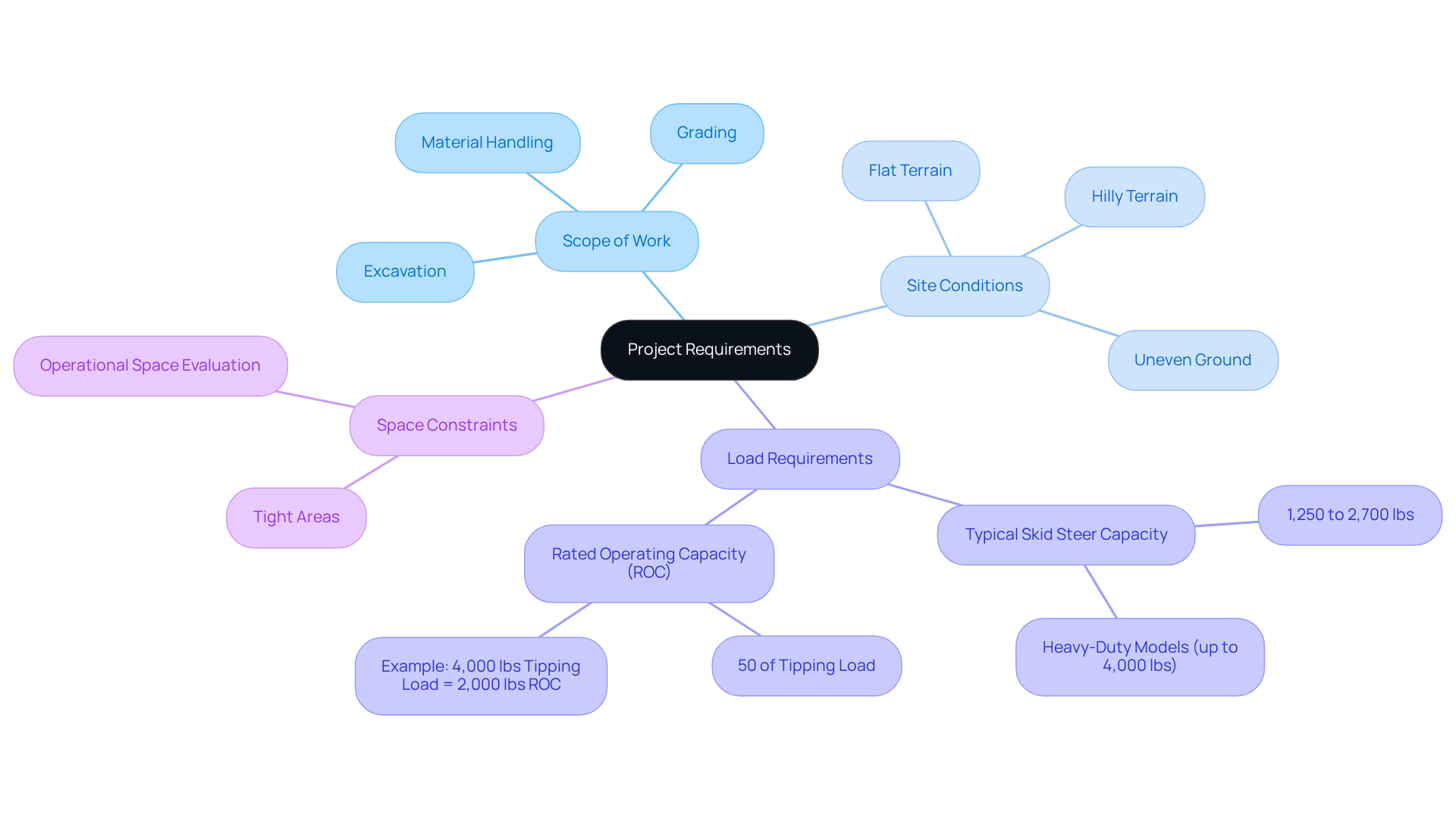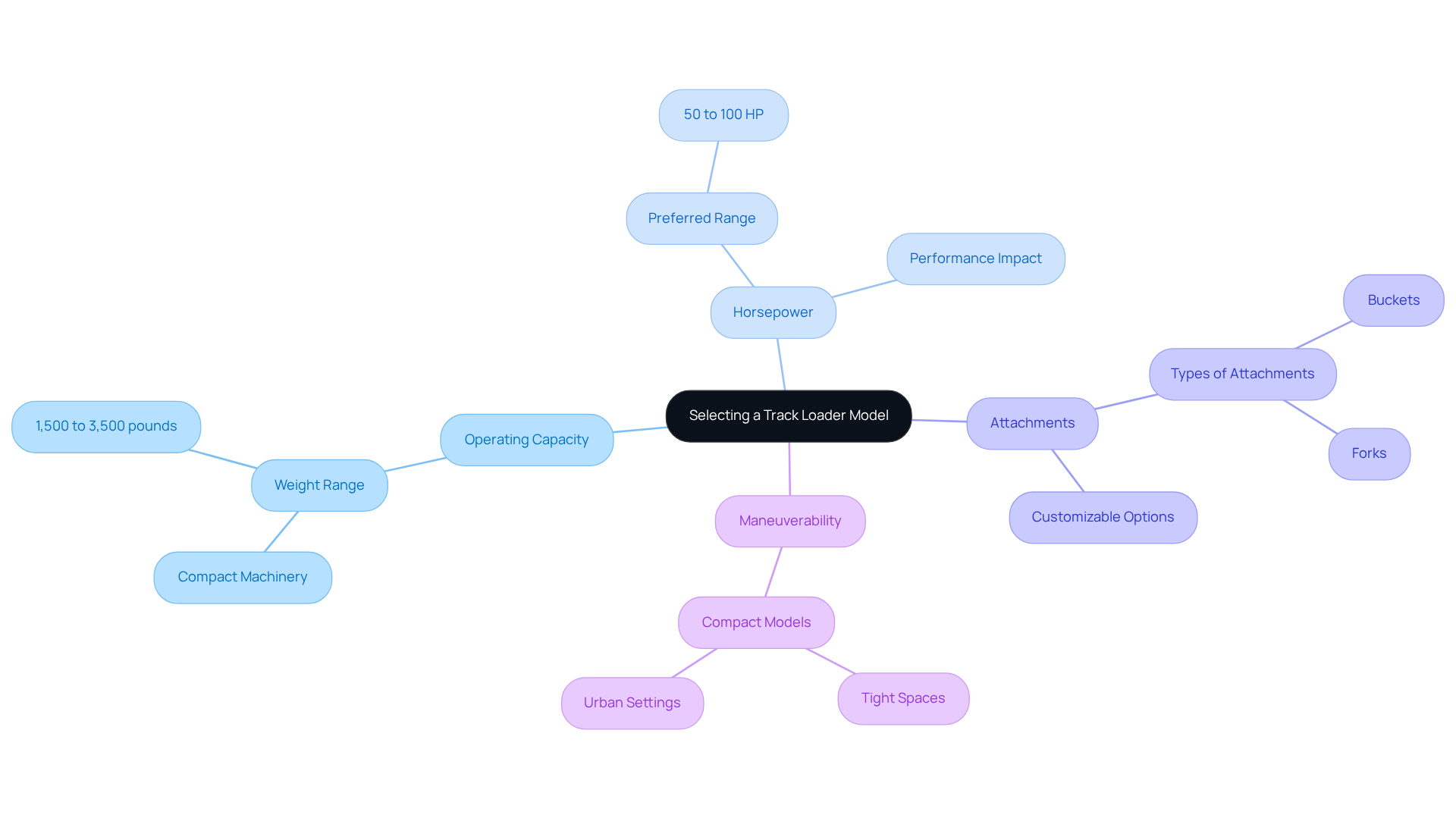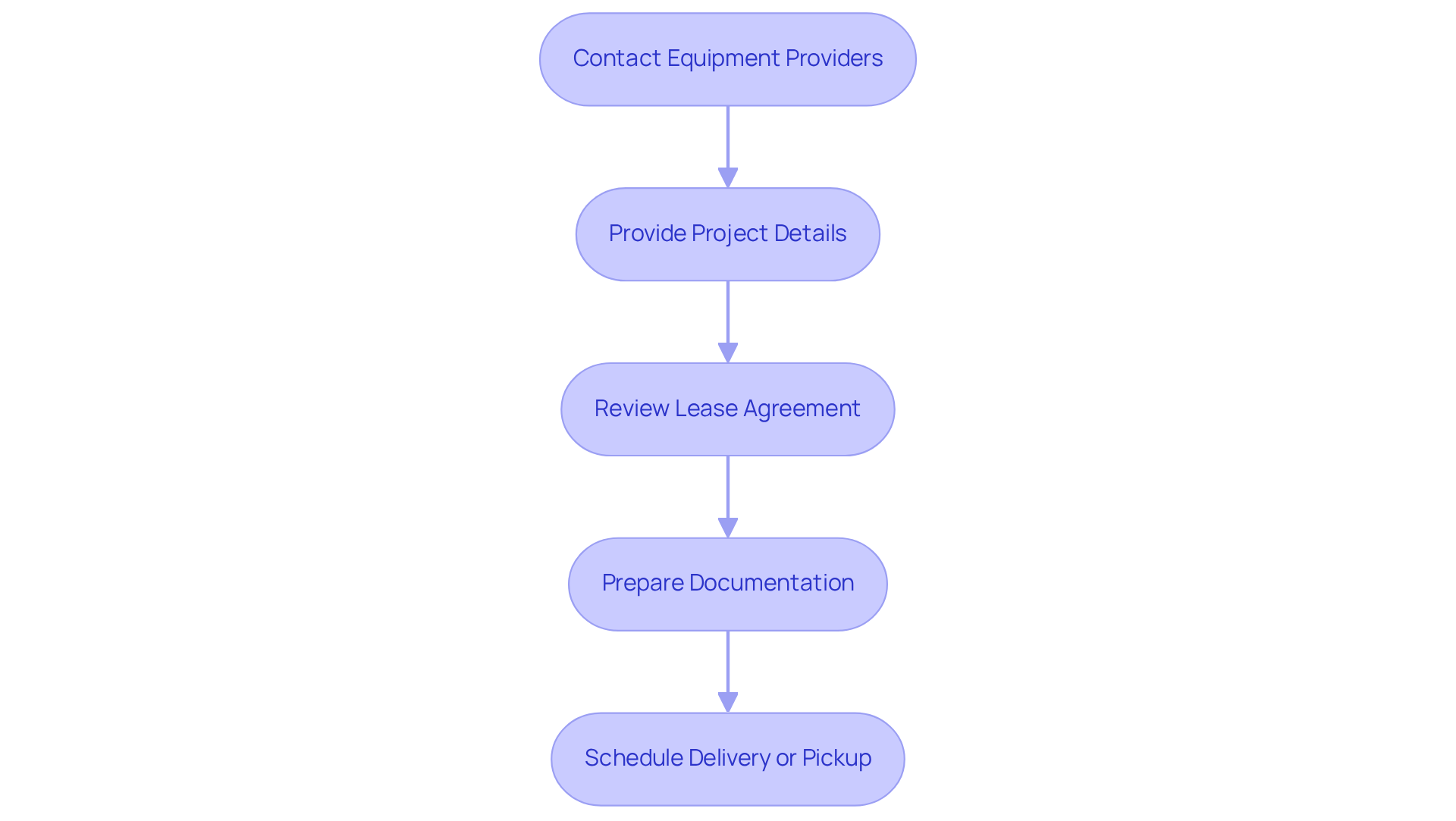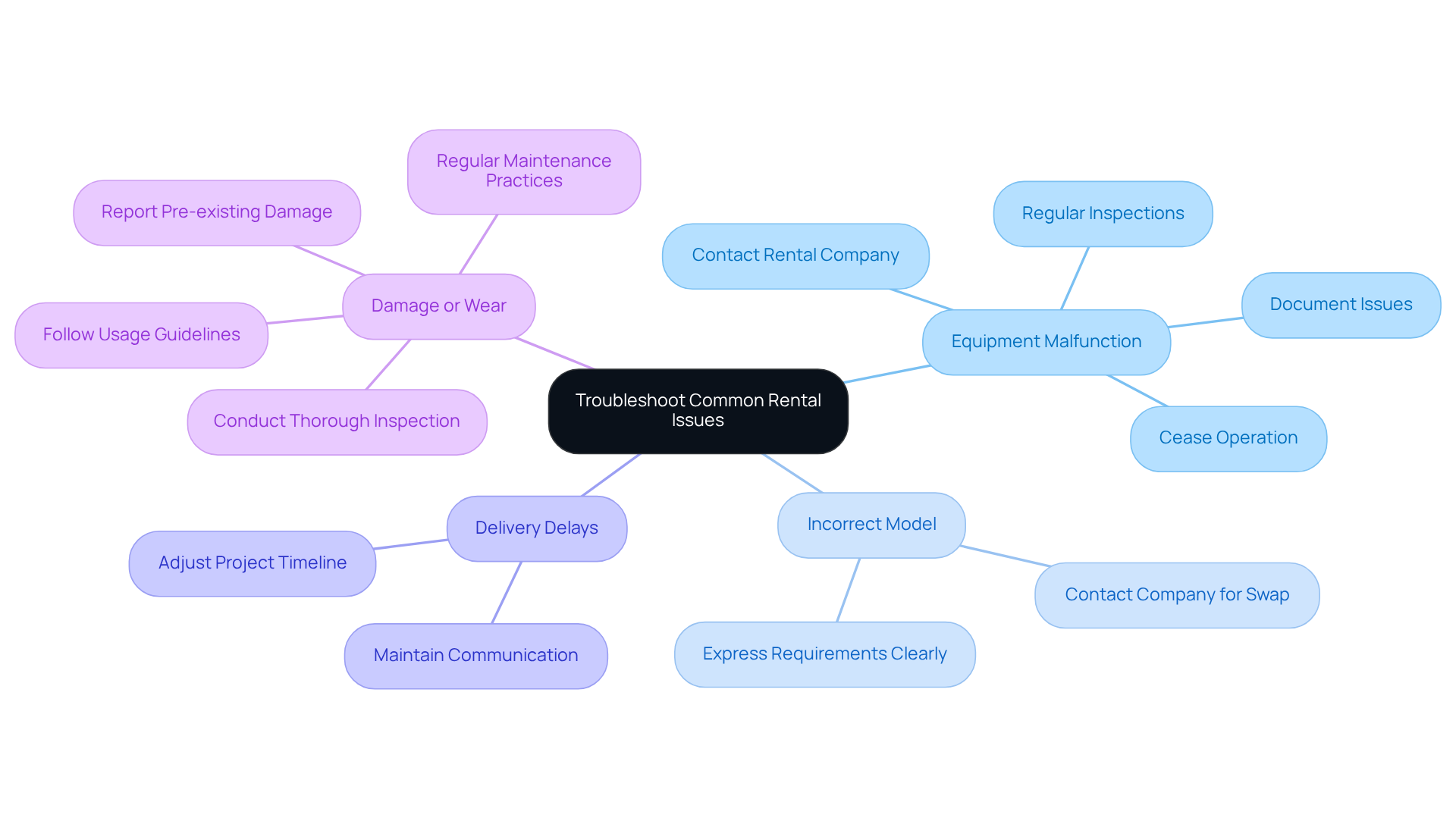Overview
Renting a track loader for your construction project involves four essential steps:
- Assessing project requirements
- Selecting the appropriate model
- Navigating the rental process
- Troubleshooting common issues
Understanding specific project needs is crucial; it allows you to choose a loader that precisely meets those requirements. Furthermore, effective communication with rental companies is key to securing the right equipment. Finally, being prepared to address potential problems will ensure a smooth rental experience, maximizing efficiency and productivity on your job site.
Key Highlights:
- Assess project requirements, including scope of work, site conditions, load requirements, and space constraints, to determine the appropriate track loader.
- Select a track loader based on operating capacity, horsepower, necessary attachments, and manoeuvrability for the job site.
- Contact local equipment providers to confirm availability and pricing, which typically ranges from $200 to $500 per day for compact machinery.
- Review the lease agreement carefully, paying attention to usage limits, insurance, and liability clauses to avoid unexpected costs.
- Prepare necessary documentation, including a valid driver’s licence and proof of insurance, to streamline the rental process.
- Communicate effectively with the rental company to troubleshoot common issues such as equipment malfunctions, incorrect model rentals, delivery delays, and pre-existing damage.
- Conduct regular inspections and adhere to usage guidelines to prevent equipment wear and ensure optimal performance.
Introduction
Renting a track loader can be a transformative decision for construction projects. However, many professionals find themselves overwhelmed by the multitude of choices and requirements. By understanding the specific needs of a project—ranging from site conditions to equipment capabilities—contractors can significantly streamline the rental process and enhance overall efficiency.
Yet, challenges may arise if the selected loader fails to meet expectations or unexpected issues emerge during operation. This guide offers a comprehensive overview of the essential steps for successfully renting a track loader, ensuring that construction professionals are thoroughly prepared to address any obstacles that may arise.
Identify Your Project Requirements
To efficiently rent a track loader for your construction project, begin by carefully assessing the specific tasks involved. Consider the following factors:
- Scope of Work: Identify the primary tasks required, such as excavation, grading, or material handling. Comprehending the scope will assist in deciding the kind of equipment required.
- Site Conditions: Evaluate the ground where the machine will function. Is it flat, hilly, or uneven? This will influence the choice of equipment, as some models perform better in specific conditions.
- Load Requirements: Determine the weight that the equipment must handle, including the materials to be moved. Most skid steers can lift between 1,250 to 2,700 pounds, while heavy-duty skid steers can lift up to 4,000 pounds. Knowing the load requirements is crucial for selecting a machine with the appropriate rated operating capacity (ROC), which is typically 50% of a skid steer’s tipping load.
- Space Constraints: Evaluate the operational space available. Are there tight areas where the machine will need to navigate? This consideration will affect the size and type of rent track loader you choose.
Developing a checklist of these requirements will simplify your selection process, ensuring that you select the appropriate equipment for your specific needs. As one manager observed, "Recognizing requirements early is crucial for effective equipment rental and execution of the task." By following these steps, you can enhance efficiency and safety on your job site. Additionally, with 74.5% of construction companies reporting renting equipment within the past year, understanding these factors is more relevant than ever.

Select the Appropriate Track Loader Model
When selecting a vehicle for your construction project, it is crucial to consider whether you need to rent a track loader that aligns with specific project requirements. Consider the following key factors:
- Operating Capacity: Ensure that the loader can handle the weight of the materials you plan to move. For instance, compact machinery typically has an operating capacity ranging from 1,500 to over 3,500 pounds, making them suitable for various tasks in construction and landscaping.
- Horsepower: Choosing a model with higher horsepower can significantly improve performance, particularly in demanding applications. Loaders with horsepower between 50 and 100 are often favored for their balance of power and efficiency.
- Attachments: Evaluate whether you need specific attachments, such as buckets or forks, and verify that the selected model is compatible. The increasing trend towards customizable attachments provides greater versatility for handling diverse tasks.
- Maneuverability: If your work site is limited by tight spaces, consider compact models that excel in navigating such environments. Compact machinery is designed to operate effectively in urban settings, where their smaller footprint can be a considerable advantage.
In addition to compact machines, integrating forklifts into your project can greatly enhance construction efficiency and safety. Forklifts are essential for lifting heavy materials and moving equipment around the site, complementing the capabilities of tracked vehicles. Engaging with leasing firms can provide valuable insights and advice tailored to your needs, ensuring you select the most suitable crawler vehicle model while recognizing the benefits of utilizing both crawler vehicles and forklifts together, especially when you rent a track loader.

Navigate the Rental Process
To successfully rent a track loader for your construction project, follow these essential steps:
-
Reach Out to Equipment Providers: Begin by contacting local equipment firms, such as EZ Equipment Rental, to confirm the availability of earthmoving machines and inquire about pricing options. Daily rental costs for compact machinery typically range from $200 to $500, depending on the model and specifications.
-
Provide project details by clearly articulating your project requirements, including the specific type of track loader needed for its intended use. This information enables leasing companies to recommend the most suitable equipment for your tasks, whether it’s for landscaping, grading, or demolition.
-
Review Lease Agreement: Carefully scrutinize the lease agreement before signing. Pay close attention to terms related to usage limits, insurance coverage, and liability clauses. Understanding these details can help you avoid unexpected expenses and ensure compliance with leasing policies.
-
Documentation: Prepare the necessary documentation, which may include a valid driver’s license, proof of insurance, and a credit card for the deposit. Having these documents ready will streamline the leasing process.
-
Schedule Delivery or Pickup: Decide whether you will pick up the equipment or prefer it to be delivered to your job site. Confirm the delivery schedule with the leasing company to ensure timely access to the equipment.
By following these steps, you can effectively navigate the equipment leasing process to rent a track loader that suits your construction needs. Furthermore, maintaining open communication with leasing representatives is advisable, as they can offer valuable insights and best practices to enhance your experience.

Troubleshoot Common Rental Issues
When you rent a track loader, several common problems may arise. Effectively troubleshooting these issues is essential for a smooth operation.
-
Equipment Malfunction: If the loader is not functioning properly, cease operation immediately and contact the rental company for assistance. Document the issue thoroughly for reference, as this can expedite the resolution process. Regular inspections are crucial to prevent malfunctions, ensuring that hydraulic systems and electrical components operate optimally. Industry insights indicate that electrical failures can lead to significant downtime, making prompt communication essential.
-
Incorrect Model: If you discover that the borrowed model does not meet your needs, swiftly contact the company to explore options for swapping it for a more suitable model. For example, if you rent a track loader that is compact but require a larger model for your task, clearly express your requirements to the leasing company. Clear communication is vital to ensure you have the right equipment for your needs.
-
Delivery Delays: In the event of delivery delays, maintain open lines of communication with the leasing company to receive updates. This proactive approach allows you to adjust your project timeline accordingly, minimizing disruptions. The typical response time for leasing firms addressing equipment issues can vary, but remaining informed aids in managing expectations.
-
Damage or Wear: Before using the equipment, conduct a thorough inspection and report any pre-existing damage to avoid potential charges upon return. Adhering to the rental company’s usage guidelines is crucial for minimizing wear and tear, which can lead to costly repairs and downtime. Regular maintenance practices can significantly enhance the longevity and efficiency of the equipment. As Rose Morrison emphasizes, good equipment management practices can prevent issues like excessive wear and ensure optimal performance.

Conclusion
Renting a track loader for a construction project is not merely a logistical decision; it is a strategic move that can dramatically enhance operational efficiency and project success. By understanding the specific requirements of the project, selecting the right model, navigating the rental process, and troubleshooting potential issues, construction professionals can create a seamless experience. Prioritizing these aspects ensures that the appropriate equipment is available to meet project needs effectively.
Key considerations include:
- Assessing the project scope
- Evaluating site conditions
- Determining load requirements
- Understanding space constraints
These factors are instrumental in guiding the selection of the right track loader model, which must align with the necessary operational capacity and horsepower for the tasks at hand. Furthermore, effectively navigating the rental process—from contacting providers to reviewing lease agreements—ensures that all logistical details are meticulously addressed. Lastly, being prepared to troubleshoot common rental issues can prevent costly downtime and facilitate smooth operations on the job site.
Ultimately, viewing the process of renting a track loader as a strategic investment in the success of a construction project is crucial. By thoroughly evaluating project needs and engaging with reputable equipment providers, construction teams can maximize productivity, minimize risks, and ensure projects are completed on time and within budget. Embracing these best practices not only enhances immediate project outcomes but also lays a solid foundation for future successes in construction endeavors.
Frequently Asked Questions
What are the first steps to take when renting a track loader for a construction project?
Begin by carefully assessing the specific tasks involved in your project, including the scope of work, site conditions, load requirements, and space constraints.
How does the scope of work influence equipment selection?
The scope of work helps identify the primary tasks required, such as excavation, grading, or material handling, which assists in deciding the kind of equipment needed.
Why is it important to evaluate site conditions before renting a track loader?
Site conditions, such as whether the ground is flat, hilly, or uneven, influence the choice of equipment, as some models perform better in specific conditions.
What should I consider regarding load requirements when renting a track loader?
Determine the weight the equipment must handle, including the materials to be moved. Skid steers typically lift between 1,250 to 2,700 pounds, while heavy-duty skid steers can lift up to 4,000 pounds. Knowing these requirements is crucial for selecting a machine with the appropriate rated operating capacity (ROC).
How do space constraints affect the choice of track loader?
Evaluating the operational space available is important, especially if there are tight areas the machine will need to navigate. This consideration will affect the size and type of track loader you choose.
What is the benefit of developing a checklist of requirements for renting equipment?
A checklist simplifies the selection process, ensuring that you choose the appropriate equipment for your specific needs, which enhances efficiency and safety on the job site.
How common is it for construction companies to rent equipment?
Approximately 74.5% of construction companies reported renting equipment within the past year, highlighting the relevance of understanding equipment rental factors.




